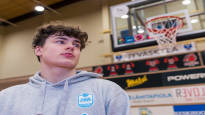A Jyvä villager who plays basketball in the first division Roope Filtness18, was away from the court for almost the entire last season.
A little over a year ago, Filtness suffered from nagging back pain. At first, a muscle injury was suspected as the cause of the pain.
– I did rotations and other movements. When they didn’t help, the back was photographed. A stress fracture and a detached vertebra were found there, remember Roope Filtness.
After the diagnosis, the young man’s mind had time to run through many things.
– How long will I have to be sidelined or will I ever be able to play basketball again, times Filtness.
In recent years, strain injuries among young athletes have increased at an accelerating rate. They are most often seen in 12- to 18-year-olds, regardless of sport or gender.
The increase in stress injuries is not a new thing. Doctors and Physiotherapists who work with athletes agree that the phenomenon has many causes.
Weak control of the middle body as one reason
University of Jyväskylä Faculty of Physical Education Professor and Specialist Doctor of Physical Education Jari Parkkari brings out the psoas muscle, which is important for pelvic control.
In his opinion, strengthening the deepest muscle of the middle body has been neglected.
– The psoas major is the most important muscle supporting the pelvis. It is activated when you do abdominal muscle movements with someone holding your ankles. That has largely been abandoned in sports, says Parkkari.
According to Parkkar, a strong psoas muscle, more commonly known as the hip flexor, prevents stress injuries of the lower limbs in addition to the back.
– If the pelvis is in a neutral position, the lower limbs are not subjected to such strong forces and the risk of injuries decreases, says Parkkari.
Institute of elite sports Kihu lä¤kari Krista Tapaninaho says that the medical community does not unanimously point to the weakness of the psoas muscle, which attaches to the lower part of the spine and the hip.
In his opinion, it is a big whole, which in addition to the control of the middle body, also includes the total load and nutrition.
– We have athletes for whom rehabilitation is the main focus, but I would see more of the whole in question, says Krista Tapaninaho.
However, the control of the central body seems to play an essential role in relation to rest and exertion, as well as nutrition.
– Even if you eat well, for example, the energy consumption of a two-meter growing young person can be so huge that it is not enough, says Tapaninaho.
Lecture slides on the importance of rest, nutrition and side exercises were already familiar to Roope Filtness as well.
Even after the injury, their message has become even clearer.
– I have perhaps paid more attention to rest now than before. I have also strengthened the middle body, says Filtness.
Responsible physician of the Finnish Olympic Committee and the Institute of Elite Sports KIHU Maarit Valtonen according to the basic concept at this moment is that the physical characteristics of young athletes are not ready for intensive sports training.
– The basic movement of children and young people remains low. This is considered to be one of the root causes behind increased stress injuries, says Maarit Valtonen.
†There is honestly no better feeling than getting to play for a long timeâ€
Even a few decades ago, the stress-related injuries of today’s young parents could be offset by growing pains and repaired with a corset.
Nowadays, stress injuries in young athletes are often recognized in the early stages.
– For example, magnetic resonance imaging is a fairly new method for us doctors, says Maarit Valtonen.
The awareness of coaches and coaching groups about stress injuries has also increased, and the stress load of young athletes can be regulated.
For example, at the Jyväskylä Basketball Academy, the training load is gradually increased for several weeks for new young players who join.
– It has contributed to the fact that head injuries have occurred very little after such a process, says JBA’s head coach Mikko Tupamäkiwho also works as the head coach of the Finnish under-20 men’s national team.
Rehabilitating Roope Filtness’s back finally took more than half a year. The rehabilitation started with rest, after that they started correcting the wrong positions in the back and strengthening the supporting muscles.
After last season ruined by injury, Filtness returned to games in the fall.
– There is honestly no better feeling than having a long time to play, says Filtness.
